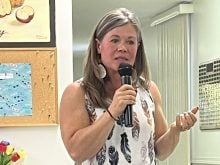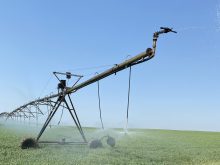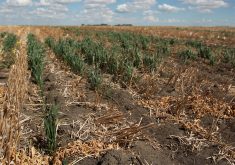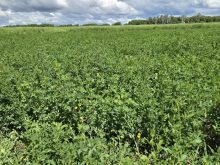The use of irrigation in Alberta’s Eastern Irrigation District has had a transformational effect on the landscape since the Canadian Pacific Railway first began the project of bringing water to the parched landscape of southeastern Alberta in the early 20th century.
One of the first British surveys of the region conducted by Capt. John Palliser in the 19th century concluded the region stretching from Lethbridge to Swift Current, which came to be known as Palliser’s Triangle, would never support agriculture.
The temperate desert region, which historically gets six inches of precipitation during the growing season, has not only supported farms but produces some of the highest value crops in Western Canada.
Read Also

Research looks to control flea beetles with RNAi
A Vancouver agri-tech company wants to give canola growers another weapon in the never-ending battle against flea beetles.
But for one of the first times since the EID was founded, this year saw a water shortage — albeit temporary — which has required irrigators to crunch the numbers to see which crops get vital moisture and when.
“In my career, this is the hardest irrigation season,” said Gord Graham, part of a multi-generational family business running South Slope Feeders in Rainier, Alta., south of Brooks.
The mountain snowpack, which feeds the Bow River and the adjacent EID reservoirs and fills the water basin each spring, was less than normal. Water that did find its way downstream came too quickly.
That, coupled with a drier than normal spring in an area already known for not producing much precipitation, saw water allotments curtailed in mid-June before a late-spring snow in the mountains and rain in the plains saw water allotments bounce back.
But the situation was a wake-up call for the Graham family, causing a reassessment of the water needs for the irrigated silage corn, wheat, canola, barley and bean crops that surround the operation.
“So many things led up to this,” said Graham. “It just kind of crept up on us.”
Despite the situation, Graham said he has confidence in the EID’s management and the irrigation expansion projects that will soon add capacity to the system.
“I’m excited about the future,” said Graham, adding the Snake Lake Reservoir project will provide significantly more reserves.
But that doesn’t mean the challenges of this season are going away.
Graham recently learned he has some choices to make, after touring fields and taking moisture samples with his sons, Dan and Travis Graham, and area farmers Blaine and Levi Johnson, as well as retired soil researcher Ross McKenzie. Their calculations show that less than two inches of rain might have fallen this season.
Even if there are no further issues with water allotments, there will still be moisture shortfalls with most of the available irrigation already applied and no rainfall in sight. When, where and to which crop to apply the remaining allotments are considerations virtually unheard of for EID irrigators.
“Something has to suffer,” said Blaine Johnson.
Johnson said this likely hasn’t been a situation faced by EID irrigators since the 1930s.
Growing high value crops is raison d’etre of the EID and expansion of irrigated acres is a core value.
But despite hopes this might just be an off year, emotions in the district are running high, said Johnson.
While a recent plebiscite passed with 75 percent of water users voting in favour to increase irrigated acres in the district by 35,000 acres to bring the district’s total to 345,000 acres, Johnson said this year’s situation might give irrigators pause for thought about further expansion.
“People are going to be more cautious, I know that,” he said.
Despite the challenges, Dan Graham expressed confidence in how the EID is managing the situation by providing clear information as to the minimum amount of water that will be made available.
“I appreciate that they tell us what they know for sure what we are getting as opposed to getting 18 (inches) and cutting it to 16,” he said.
While the district has always squeezed as much efficiency as possible out of the available water, Dan said this year has him redoubling efforts to become even more efficient.
“I’ve been thinking about that more and more,” he said. “Stretching the water further.”
Even if this year proves to be a one-time occurrence, Dan said the lessons learned in getting the most out of the water allotment will be practised on his family’s operation for years to come.
“We’re using everything we have to be as efficient as possible,” he said.
McKenzie said he’s not overly optimistic this year isn’t a sign of things to come.
The retired Alberta Agriculture soil researcher levelled criticism against the province for layoffs of individuals tasked with helping irrigators get the most out of scarce water resources during seasons like this year.
“When you have a good, well-functioning group that’s serving the industry well, from both our research side and the extension side, that’s invaluable. Farmers really depend on unbiased information from extension people and researchers,” he said. “When you let all your extension people go and all your researchers, then that valuable, unbiased, wise group of people are lost.”
With other irrigation districts also facing water shortages, the loss of that water management support is being felt across southern Alberta.
“The downside for farmers is that this is new territory. Where do you go for information to decide whether to cut two, three inches on this crop and move it onto another crop,” said McKenzie. “That kind of information is not available, so you really have to struggle to decide, just using your best judgment to make those decisions.”
He said millions of dollars have been spent by the government and farmers to develop one of the best irrigation systems, but cuts to public research, which could provide information on drought-tolerant breeds and water management, are pulling in the opposite direction.
“And that’s just going to get worse,” he said.
Alberta’s irrigation districts continue to outperform dryland operations despite only making up a little more than four percent of the province’s total cultivated land.
Combined with irrigation-supported livestock operations, the districts produce more than a quarter of total primary agriculture sales in Alberta.


















